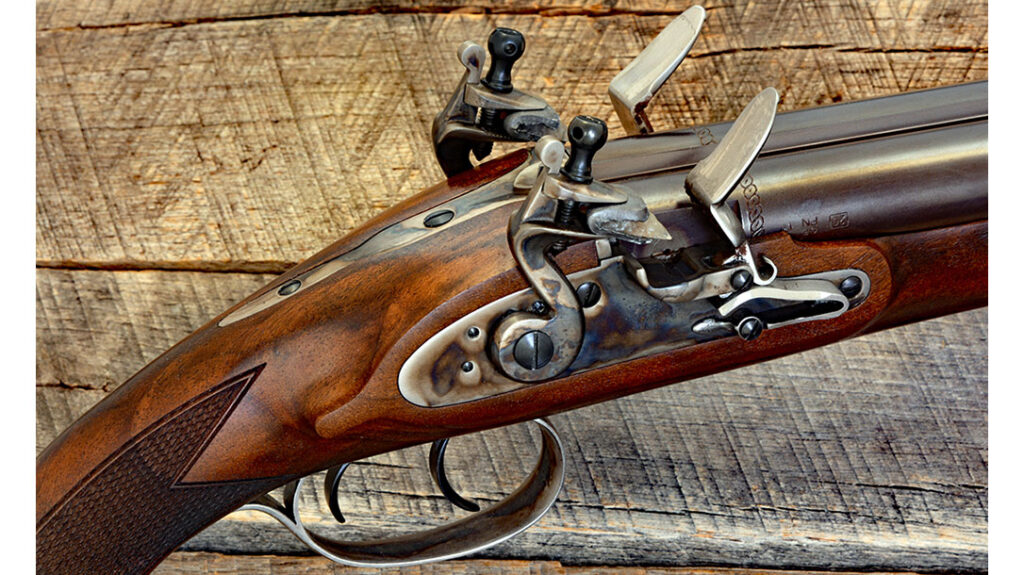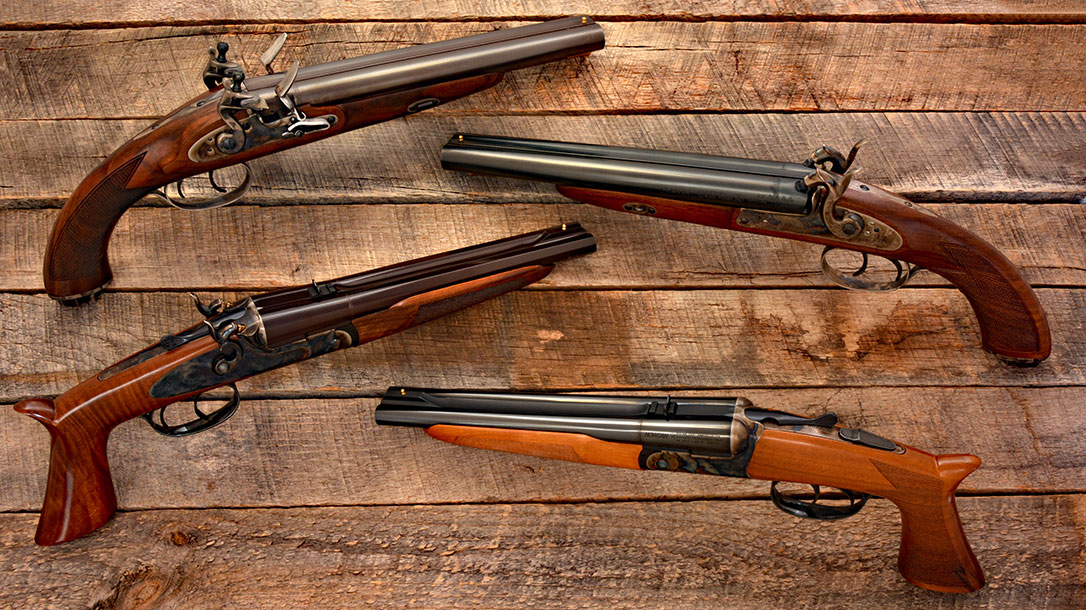The fight had begun almost instinctively. An image from a wanted poster flashed through the Sheriff’s mind as he saw the man exiting the saloon. The other man saw only the badge and look of recognition in the Sheriff’s eyes before guns were drawn and the hasty gunfight ensued. It would be a Howdah, similar to the ones recreated by Pedersoli, that would win the day.
The Howdah Legacy Leading to Pedersoli Recreations
Both men fired their six rounds to no effect. In the clouds of thick black-powder smoke, there was little time to reload. The lawman’s adversary had come well-armed with a brace of .45-caliber pistols, only one of which had been shot empty.
Withdrawing into an alley, the Sheriff sought cover, knowing the man would momentarily round the building’s corner, gun cocked and ready to collect his debt. Everything happened so quickly that the outlaw reckoned there was enough time for him to gain the upper hand.
Advertisement — Continue Reading Below
He rushed the opening onto the back street, his second .45 unlimbered and ready. The outlaw expected to catch the Sheriff trying to reload, or at best going for a pocket pistol backup.
As he turned the corner, however, there was no small-caliber report, no scene of frantic reloading. Instead, he was met by the roar of two large-caliber rounds fired in quick succession. Each leaving foot-long barrels to find their mark and bring the confrontation to an end moments after it had begun.
One town newspaper headlined it “A fair fight,” the other, which favored the well-moneyed outlaw faction that kept the saloons and gambling halls flush, labeled it “An ambush by the Sheriff,” who had offered the man no quarter.
Advertisement — Continue Reading Below
Many such scenes had played out between lawmen and desperados in the 1880s, some shootouts too famous to forget. This one was only noteworthy because the lawman in question had used an unusual backup.
A second handgun holstered out of sight on his cartridge belt. One that had gained fame half a world away in the hands of big game hunters.
Howdah’s Legacy
It was the double-barreled Howdah pistol, a handgun that had evolved over more than a century throughout Europe. To those in the Old West, it would have resembled a small sawed-off shotgun. But in the Old World the Howdah pistol had become something of a legend.
Advertisement — Continue Reading Below
It began as a large-caliber, double-barrel flintlock pistol in the 1790s, emerging as a double percussion lock gun in the early 1800s. Eventually it became a double-hammer, break-action cartridge pistol by the mid to late 19th century.
In America, the handful of Howdah Pistols seen in the 1800s likely encouraged the American sawed-off shotgun. And, by the 1920s, Ithaca’s famous double-barrel, smoothbore Auto & Burglar pistols. These were offered in a variety of bores, in Pedersoli’s case, most importantly .410 (which is actually regarded as a caliber and not an actual shotgun gauge).
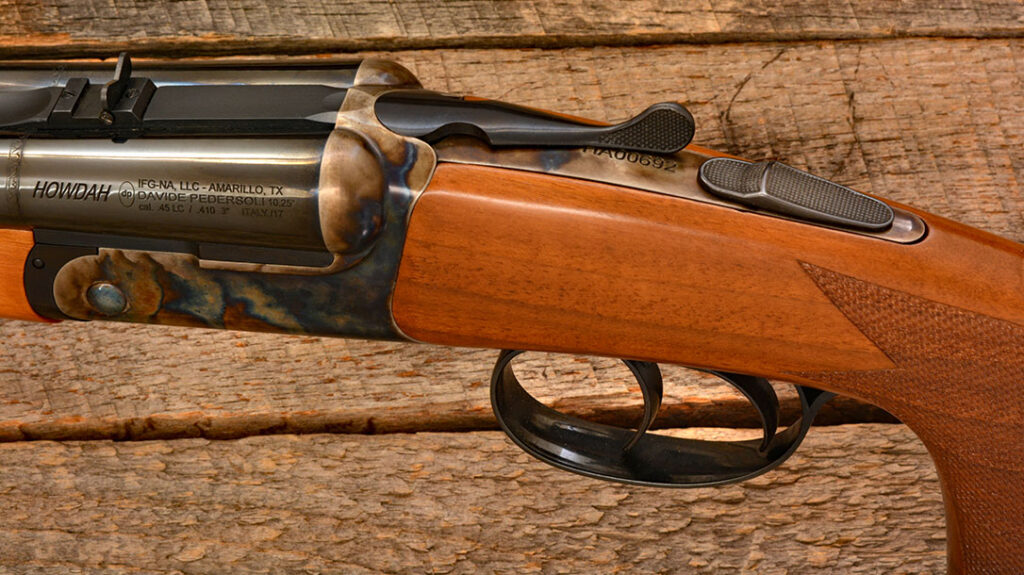
Advertisement — Continue Reading Below
Of course, back in the 1880s the .410 didn’t yet exist. The demand for the guns mainly centered on their ability to chamber rifle-caliber cartridges or larger pistol calibers than conventional revolvers of the period.
That was the Howdah’s greatest advantage. Along with the higher velocity provided by the pistol’s longer barrels. Not to mention the speed at which reloading was possible compared to a Colt or Remington-style revolver of the period.
There are also documented examples of Howdah cartridge-loading models being built in smaller pistol calibers. These include .455 Webley and even the American .44 and .44-40.
Advertisement — Continue Reading Below
Regardless of the chambering, the Howdah Pistol was always a last resort. Even for the American Ithaca Auto & Burglar pistol, regarded as a close-range weapon favored in the late 1920s and early 1930s by bank guards, sheriffs, police departments, paymasters, watchmen, and express messengers.
It was also sold by Ithaca as an ideal home-defense weapon at the time.
Hunter’s Companion
The origin of the gun’s name comes from the sedan chair or “Howdah basket” mounted on the back of an elephant for big game hunters in India.
Advertisement — Continue Reading Below
If a tiger or other wild animal charged the elephant, the Howdah was used at close range. Especially when lacking sufficient time to get off a second shot. This was usually the result of the hunter’s rifle shot missing or not having been effective.
With the 19th century designs, most notably those built in England for use in India and Africa, breech-loading Howdah pistols were large-caliber handguns, such as .577 Snyder. But by the late 19th century, more practical pistol calibers had also become common.
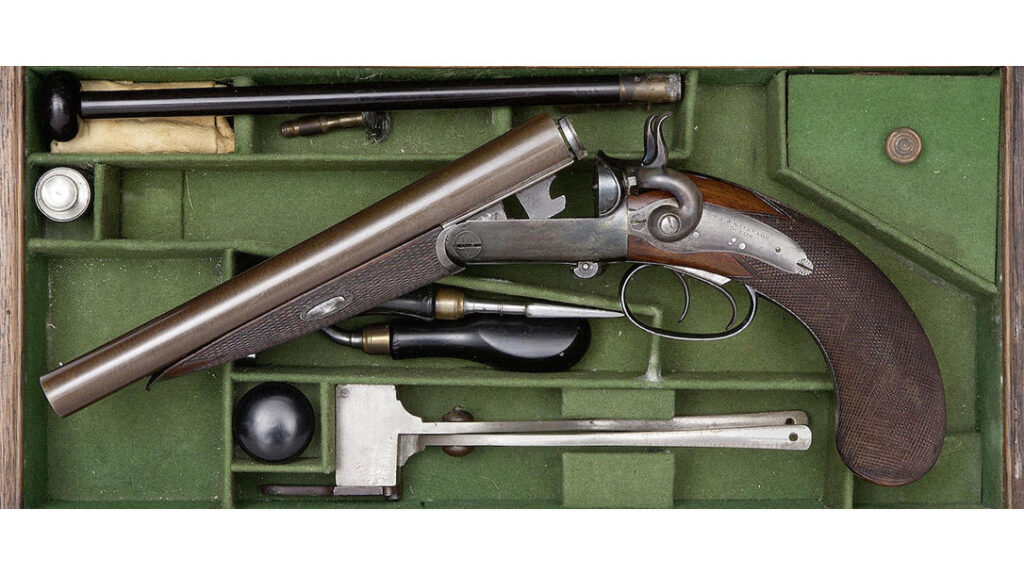
Advertisement — Continue Reading Below
This brings us to this latest variation of the Howdah Pistol from famed Italian arms maker Davide Pedersoli. Chambered in .45/410, the double-barreled pistol can also load modern .45-caliber defensive rounds. Similarly, it can also handle up to 3-inch .410 buckshot, 000 and .410-caliber slugs.
Pedersoli’s Journey
It has taken Pedersoli 15 years to make the journey from its original Howdah Hunter double-barrel muzzle-loading hammer pistol to the new Howdah Vintage breech-loading double-hammer model.
In the years between, Pedersoli added a .410 version based on the Ithaca Auto & Burglar. And last year, the Howdah Flintlock derived from the original 1790’s designs. In all, the four models nicely bookend the history of the Howdah Pistol design up through the 1920s.
Advertisement — Continue Reading Below
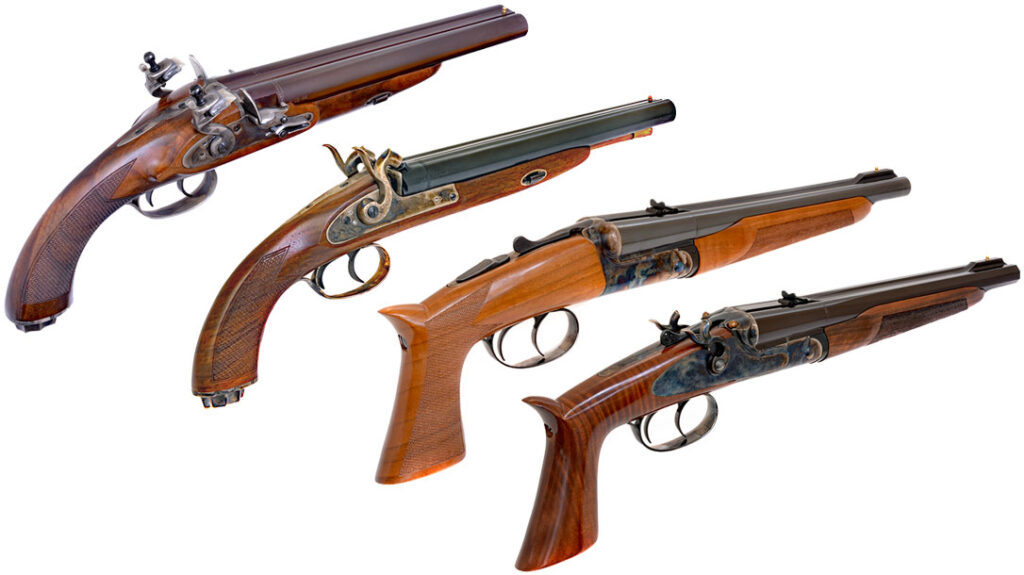
The first Pedersoli Howdah Hunter pistols in 20×20 gauge, .50 caliber, and also in a dual .50-caliber and 20-gauge combination, became something of a cult gun in the early 2000s. Even today, you will find countless videos online of the guns being reviewed and fired.
The 18th-century design Flintlock Howdah chambered in 20×20 gauge (uses a patched .610 round ball weighing 324 grains), though a masterpiece of construction and quite enjoyable to shoot, also presents the same shooting challenges as most flintlock muzzle-loaders, which the Hunter models eschew with their more reliable and easily handled percussion locks.
Pedersoli’s Auto & Burglar-inspired design was a more contemporary, cartridge-loading hammerless double gun with rifled barrels. It has an Ithaca-style pistol grip featuring an integrated spur to help stabilize the .410 in the hand during recoil.
The pistol grip spur, which rests firmly in the web of the shooter’s hand, was also seen on many European Howdah pistols in the late 19th century. This is the model that the newest “retro style” hammer gun is based upon.
However, there are a number of significant differences that set the Pedersoli Howdah Vintage apart from the Ithaca design. And for that matter, traditional Howdah designs of the late 19th century.
Same But Different
The .45/.410 Vintage model starts with a stock design similar to the Auto & Burglar. However, what fills the handsome walnut grip and checkered, splinter forend is something unique to Pedersoli’s design.
The most significant difference between the actual Ithaca Auto & Burglar and the Pedersoli Hammerless is the length of the receiver and grip angle. It is elongated on the Pedersoli due to the action they use (on both .45/.410 Howdah models).
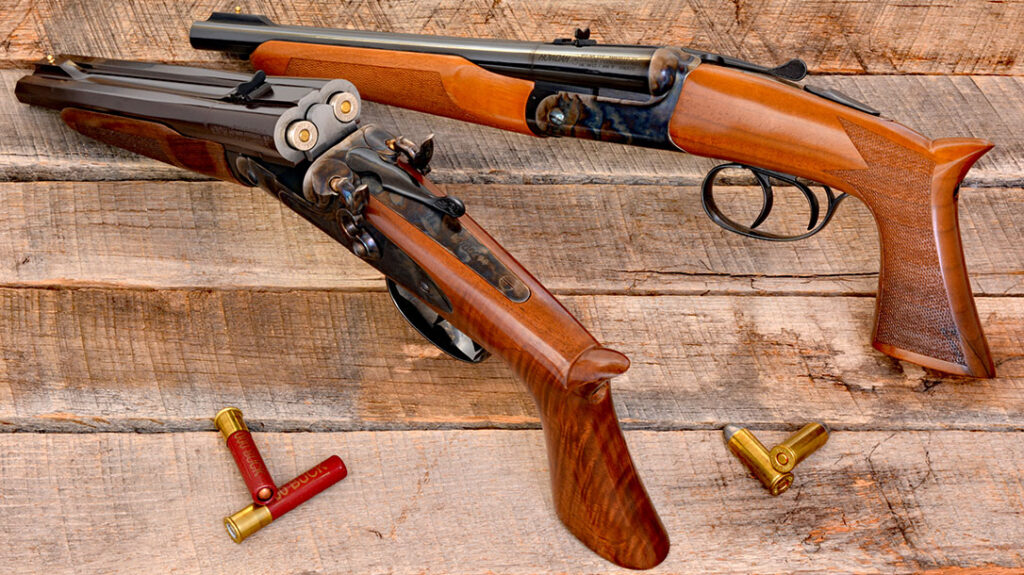
This added length extends the reach to the triggers and shifts the pistol’s center of balance forward. Thus, making a two-handed hold all but mandatory to shoot the Pedersoli.
There is also a big difference between the two Pedersoli models. The Ithaca-based hammerless Howdah model uses an integrated boxlock action. It is based on the Anson and Deeley design developed in 1875 for the Westley-Richards Company.
This is accented by a color case-hardened receiver and tang, high-polish, blued round barrels, blued triggerguard, triggers, lever and checkered sliding auto-reset tang safety. The barrels boast a broad center rib, allowing a folding rear leaf sight and a ramped brass bead front sight.

On the new Vintage, the pistol uses external hammers and a sidelock design. However, it uses the same receiver length and grip angle as the Hammerless. The most interesting difference is the polished browned finish on the barrels. They also have a distinctive round-to-octagonal taper beginning just forward of the break-barrel hinge.
The hammers themselves can only be described as “demur” compared to traditional Howdah Pistol hammers. They are also color-case hardened to match the round body receiver, lock plates, and tang. This all adds to the Pedersoli’s visual appeal.
Elegant Styling of Pedersoli’s Versions
What really catches the eye is the Pedersoli’s elegant round-to-octagonal barrels. These are not common on original 19th-century side-by-side Howdah pistols. Some have been seen with full octagonal barrels, but nearly all such examples are superposed (over/under) guns.
The Vintage uses the same folding rear leaf sight and ramped brass bead front as the hammerless model. Likewise, the barrels share the same monoblock design. It utilizes two lugs and a horizontal wedge inserted on the frame that fits inside the lugs when the action is closed.
The Howdah locks up tight as a vault door. The gun is otherwise traditional in outward appearance. However, internally, Pedersoli uses coil mainsprings for the hammers rather than the customary V mainsprings. This seems to make the small hammers easier to cock. But that is strictly subjective since there is nothing with which to compare them.
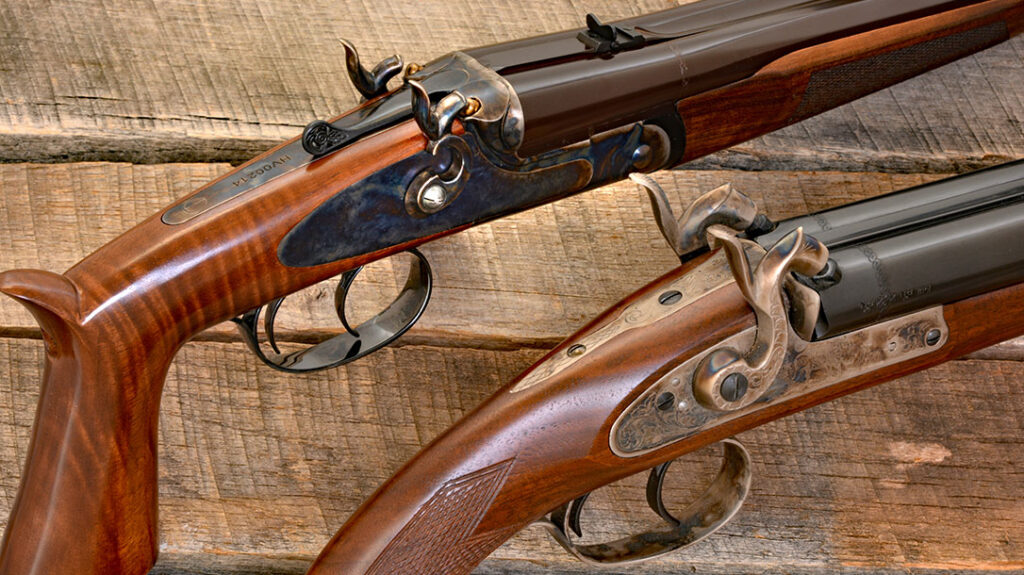
The small size of the hammers really stands out, given the overall dimensions of the Howdah Vintage. They are less than half the size of the hammers on the original Pedersoli Howdah Hunter percussion models. Likewise, they almost look disproportionate to the rest of the gun.
Is this size disparity aesthetically displeasing? Somehow not, as the entire Howdah Vintage is uniquely its own gun and different in overall appearance to 19th-century examples.
Loads & Accuracy
Considering the Howdah Vintage is the same fundamental design as the hammerless Ithaca design .45/.410, the shooting and handling are very near the same. For the range test, I shot traditional 200-grain RNFP .45 Colt and modern Hornady Critical Defense .45 Colt 185-grain FTX. And in .410 I tested Federal Premium 2.5-inch 000 buckshot.
The 000-shot shells deliver four .36-caliber-sized lead pellets, making this an ideal close-quarters weapon. Test targets were positioned at 7 yards for buckshot and 15 yards for the .45 Colt and .45 FTX cartridges.
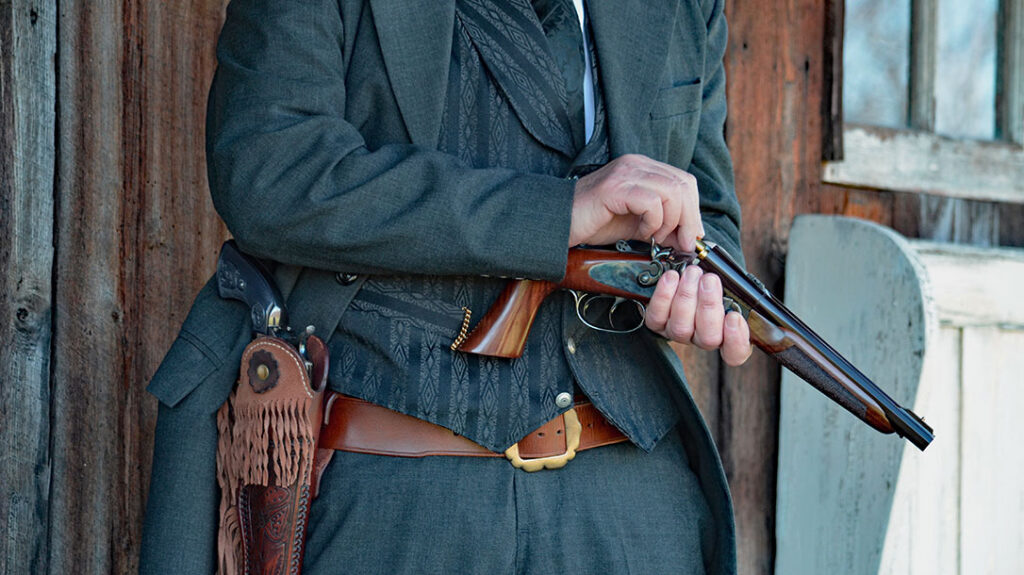
With 10.5-inch barrels and a weight of 4.5 pounds (empty), recoil with the .45-caliber rounds was moderate. As was Federal Premium Personal Defense 000 buckshot. The heavier-hitting Critical Defense FTX requires a strong support handhold with fingers wrapped over the edge of the barrels.
Recoil, as expected, is heavy but still manageable. Correspondingly, the Pedersoli does not ride back in the hand due to the grip angle and grip spur. This keeps the pistol centered in the web of the shooting hand, even during heavy recoil.
The best hold on the gun is with the strong side arm extended (a Weaver stance works well) with the support hand firmly grasping the forearm.
Shooting the Howdah
Trigger pull averaged 3.3 pounds for the front trigger and 3.6 pounds for the rear. Both were noticeably lighter than the trigger pull on the Hammerless model. It averaged 4.1 pounds front and rear.
Average velocity for the .45-caliber Hornady Critical Defense 185-grain FTX was 1,070 feet per second (fps). The 200-grain .45 Colt, a comparatively low-velocity round compared to the FTX, clocked an average of 653 fps. However, the .410 Federal Premium Personal Defense 000 buckshot load cleared the chronograph traps at an average of 1,025 fps.
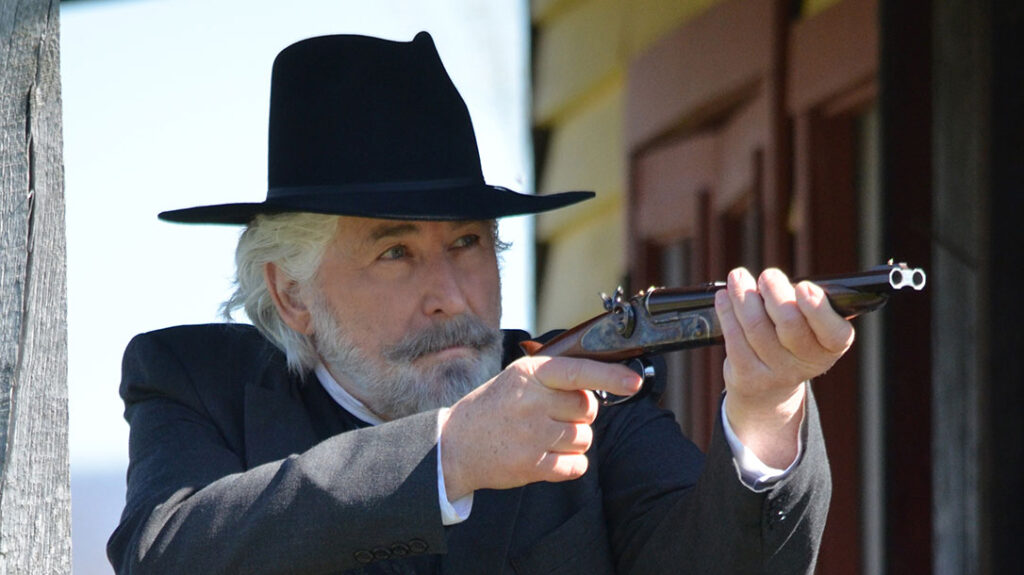
I shot two sets of rounds with each brand of ammo, with average shot groups measuring 2.5 to 3.25 inches. Hornady 185-grain FTX .45 Colt rounds all struck the target’s center body mass.
Barrel regulation was very close at this range, with the left and right barrels splitting the distance from POA. Shooting 000 buckshot, the Federal Premium groups measured 1.5 to 2.0 inches for the four .36-caliber-sized lead balls. The .45 Colt rounds had a spread of 2.5 inches, also center body mass.
Final Notes
In terms of handling, the Pedersoli is about as basic as it gets. Think double-barrel shotgun scaled down to pistol size but with the same manual of operation. One lever to open it, load two rounds, close the action, and you are ready.
As a vintage firearm from the late 1800s, the Pedersoli lives up to the reputation of famous Howdah pistols from the past, albeit in a smaller caliber. As a defensive handgun, the new Pedersoli offers the same advantages as the Ithaca-based Hammerless model.
Loaded with modern ammunition, the Vintage is just as good with the option of cocking your own hammers. Thus doing away with the auto-reset tang safety on the hammerless double-gun model.
So, is this Pedersoli’s best Howdah Pistol yet—hammer gun versus hammerless? Well, it’s very much like that Old West shootout between the Sheriff and the outlaw. It all depends upon which newspaper you read!
For more information, visit here.
Pedersoli Howdah Specs
Caliber: .45 Colt/.410
Barrels: 10.25 inches
Overall Length: 17 inches
Weight: 4.5 pounds (empty)
Sights: Brass bead front, folding leaf rear
Stock: Walnut
Action: Sidelock, exposed hammers
Finish: Browned barrels, color-case hardened steel furniture
Capacity: 2
MSRP: $2,035
Performance
| LOAD | VELOCITY | ACCURACY |
| .410 | ||
| Federal Premium Personal Defense 000 | 1,050 | 1.50 |
| .45 Colt | ||
| Hornady Critical Defense 185 FTX | 1,070 | 2.50 |
| Ten-X 200 RNFP | 653 | 2.50 |
Bullet weight measured in grains, velocity in feet per second (fps) by chronograph and accuracy in inches for best 000 buckshot patterns at 7 yards and .45 Colt groups at 15 yards.
